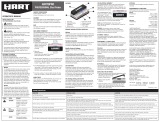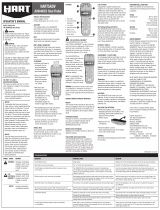Page is loading ...

reedinstruments
www com
Model LA-1010
Stud/Metal/AC
Voltage
Detector
Instruction
Manual
REED Instruments
1-877-849-2127 | [email protected] | www.reedinstruments.com

reedinstruments
www com
2
Table of Contents
Safety ............................................................................................ 3
Features ......................................................................................... 4
Specications ................................................................................ 4
Operating Instructions ................................................................5-7
Calibration ..................................................................................5
Detecting Wood Studs .............................................................5-6
Detecting Metal Studs ................................................................. 6
Detecting Live Wires ................................................................... 6
Adjustment Feet .......................................................................... 6
Operating Tips .........................................................................6-7
Battery Replacement ..................................................................... 7
For service on this or any other REED product or information on other
REED products, contact REED Instruments at info@reedinstruments.com
REED Instruments
1-877-849-2127 | [email protected] | www.reedinstruments.com

reedinstruments
www com
3
Safety
The following warnings must be followed to avoid injury.
• DO NOT remove warning labels
• DO NOT use optical tools such as a transit to view laser beam as
serious eye injury could result
• DO NOT project the laser beam directly into the eyes of others
• DO NOT stare directly at the laser beam
• DO NOT project laser beam onto a reective surface
• DO NOT operate around children, or allow children to operate
• DO NOT disassemble the laser
• Always turn off the laser when this tool is not in use
IMPORTANT
Read all instructions prior to operating the unit and DO NOT remove any
labels from the tool. The unit produces a straight line on the same surface
on which the tool is placed. Any reection of the line on another surface
should be considered reference. You should always use caution when
nailing, cutting or drilling in walls, ceilings and oors that may contain
wiring or pipes near the surface.
CAUTION
Shielded, dead or non-powered wiring will not be detected as live wires.
Always remember that studs or joists are normally spaced 16 inches or 24
inches apart and are 1-1/2 inches in width. To avoid surprises, be aware
that anything closer together or of a different width may be an additional a
stud, joist or rebreak.
When working near AC electrical wires, always turn off the power.
Note
The unit is designed to detect 110 volts (for USA version) and 230 volts
for (European version) AC in live electrical wires. It will also detect the
presence of live wires having greater than 230 volts.
REED Instruments
1-877-849-2127 | [email protected] | www.reedinstruments.com

reedinstruments
www com
4
Features
• Stud/metal/AC voltage nder with laser line level
• Select normal scan, detect up to 3/4” depth, or deep scan, detection up
to 1-1/2” depth
• 180° pivoting laser plane with level and plumb vials
• Thumb dial adjustment feet for leveling the laser
• 20’ laser line projection onto work surface with 90° squaring
• LED display with continuous live wire detection
• LCD sensing and mode display with target graphics
• Vertical and horizontal mounting holes
• Easy keypad operation
• Ergonomically designed for comfort and grip
• Auto power off
Specifications
Operating Temperature: 20 to 120ºF (-7 to 49ºC)
Storage Temperature: -20 to 150ºF (-29 to 66ºC)
Laser Diode: 650nm class IIIA
Laser Accuracy: 1/2” at 20ft
Length of Projected Laser Line: Up to 20ft
Power Supply: One 9V battery
Weight: 180g
Dimensions: 180 x 67 x 38mm
Optional Accessories: Soft carrying case (model CA-03)
REED Instruments
1-877-849-2127 | [email protected] | www.reedinstruments.com

reedinstruments
www com
5
Operating Instructions
Calibration
Calibrate this unit on a wall before scanning for wood or metal studs.
Note: Before you calibrate be sure to not place this unit directly over a
stud, dense material (such as metal), wet areas, or newly painted areas
as this will prevent the unit from calibrating properly. If this is done over a
wood or metal stud the unit will give no indication when moved away from
that area.
1. Hold the unit at against the wall surface, making rm contact.
Press and hold the ON button. All indicators on the LCD are
displayed while the unit goes through its’ 1 to 3 second calibration
cycle. When calibrated, a beep will sound and LCD will indicate, as
shown in illustration 1.
2. Press the laser key and hold the ON button; then the laser line will
stay on.
3. Keep holding ON button during the stud detection.
Detecting Wood Studs
Wood stud detection is set by default when the unit is rst turned on.
1. Slide the unit across the surface in a straight line, the closer the
unit is to the stud the more bars will be shown (see illustration 2).
2. When the stud edge is detected the wood indicator and the edge
bar will be shown (see illustration 3) and the unit will sound a
repeating beep.
Illustration 1 Illustration 2 Illustration 3
continued ...
REED Instruments
1-877-849-2127 | [email protected] | www.reedinstruments.com

reedinstruments
www com
6
3. Use the indicator line to mark the stud edge with a pencil.
4. Continue sliding past the stud, when the indicator turns off and the
unit stops beeping, the other edge has been detected.
5. Double-check the stud’s location by coming back from the other
direction (be sure to make additional markings).
6. The midpoint of the marks indicates the stud center.
Detecting Metal Studs
1. Press the METAL button once and word METAL will show on the
LCD screen.
2. Press & keep holding the ON button during the time of stud
detection.
3. Repeat the procedures 1-5 as described in detecting wood studs.
Detecting Live Wires
The live wire detection feature is always on and when a live wire is
detected, the red live wire LED indicator will show. Static electricity charg-
es that can develop on drywall and other surfaces will spread the voltage
detection area many inches to each side of the actual electrical wire. To
aid in locating the wire position, scan holding the unit 1/2 inch away from
the wall surface or place your other hand on surface approximately 12
inches from sensor.
Adjustment Feet
The adjustment feet allow the leveling of the laser line on the horizontal or
vertical surfaces.
Operating Tips
IMPORTANT SAFETY NOTICE
To insure proper detection of live wires ALWAYS hold the unit in the
handle area only. Grasp between your ngers and thumb while maintain-
ing contact with your palm.
continued ...
REED Instruments
1-877-849-2127 | [email protected] | www.reedinstruments.com

reedinstruments
www com
7
Conventional Construction
Doors and windows are commonly constructed with additional studs and
headers for added stability. This unit detects the edge of these double
studs and solid headers and emits and holds an audio signal as it crosses
over them.
Surface Differences
Wallpaper—there will be no difference in the function of the stud sensor
on surfaces covered with wallpaper or fabric unless the coverings contain
metallic foil or bers.
Plaster and Lath — unless the plaster and lath is exceptionally thick or
has metal mesh in it, there will be no problem with the unit functioning
properly.
Ceiling or Textured Surfaces—When dealing with a rough surface such as
a sprayed ceiling, place a piece of cardboard under the unit when scan-
ning the surface. Run through the calibration technique described earlier
with the piece of cardboard between the stud sensor and the surface.
Also, it is particularly important in this application to remember to keep
your free hand away from the unit.
If utilizing the procedure of scanning and marking from two sides, the unit
will nd the stud center with 1/8” accuracy for wood and 1/4” accuracy
for metal. When measuring a wood or metal stud, it is recommended that
the unit to be used at 33-55% relative humidity.
Battery Replacement
1. Open the battery door on back of unit and connect a 9-volt battery
to clip.
2. Place battery back into case and snap battery door on.
3. Be sure to replace the battery immediately with a new 9-volt battery
when low battery indicator is on.
For service on this or any other REED product or information on other
REED products, contact REED Instruments at info@reedinstruments.com
REED Instruments
1-877-849-2127 | [email protected] | www.reedinstruments.com

reedinstruments
www com
8
Notes _________________________________________
________________________________________________
________________________________________________
________________________________________________
________________________________________________
________________________________________________
________________________________________________
________________________________________________
________________________________________________
________________________________________________
________________________________________________
________________________________________________
________________________________________________
________________________________________________
________________________________________________
________________________________________________
________________________________________________
________________________________________________
REED Instruments
1-877-849-2127 | [email protected] | www.reedinstruments.com
/


